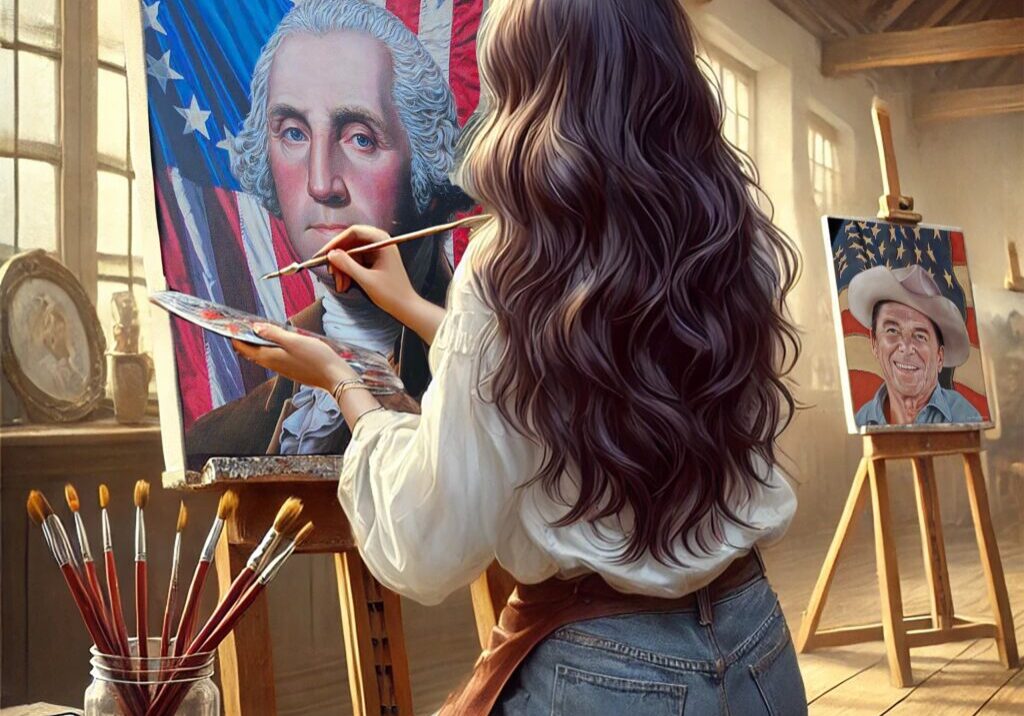
The Fonts of Freedom: Type, Tension, and Revolutionary Design
Fonts are rarely silent. Even when they’re not shouting in all caps, they’re humming beneath the words, shaping how we feel what we read. In the Revolutionary era, printers understood this intuitively. They didn’t just set type – they set tone. A single font choice could convey fury, urgency, solemnity, or defiance. As I painted the colonial newspapers and broadsides into the mural’s Unity section, I kept returning to this idea: these fonts weren’t just functional.
They were designed with purpose, often under pressure, and they became a hidden language of freedom. Today, we toggle through hundreds of fonts without much thought. But in the 1770s, a printer’s font library was a limited arsenal. Choices were physical – pieces of lead, wood, or copper stored in drawers and set by hand. Each letter had weight, not just metaphorically but literally. You could feel revolution in your palms. Printers chose fonts not just to fit columns but to charge them with mood. Blackletter fonts suggested weight and formality, ideal for declarations.
Caslon – an English typeface favored by colonial printers – offered balance and elegance, used even for the Declaration of Independence itself – But there were other fonts too. Cruder, faster, louder. These weren’t built for beauty. They were built for visibility. Thick strokes and narrow margins grabbed attention. Ragged alignment and irregular line breaks conveyed a world in flux. When a broadside needed to scream, “To ARMS!” or “A Proclamation from Congress,” it didn’t whisper. The font carried the urgency. As an artist trained in composition, I recognize this instinct – the drive to translate meaning into form, not just content. Revolutionary printers were practicing design under fire.
In the mural, you’ll find fonts hidden in plain sight. I painted them without names, because their power comes not from identification but impression. There’s a broadside nailed beside the Liberty Tree, its letters thick and uneven. There’s a newspaper headline cascading over the arm of a messenger, its words bent with speed. And though the actual content isn’t readable, the emotional tone is. That’s intentional. I wasn’t trying to replicate specific prints. I was trying to resurrect the tension they carried. Design tension is often what makes a piece vibrate. In typography, this might mean bold headers paired with narrow text columns, sharp diagonals breaking otherwise orderly layouts, or sudden shifts from serif to sans. In Revolutionary print, that tension reflected real-life disorder – of a nation breaking apart to reform itself.
The fonts carried that story, unconsciously. They weren’t polished. They were pressed into service. One of my favorite discoveries while researching these documents was how often visual awkwardness became an asset. A misaligned paragraph, a doubled letter, or a headline crammed too tightly – all of it reminded readers that this wasn’t polished propaganda from an empire. This was homemade dissent. Even the design mistakes told the truth. I kept that in mind while painting: don’t over-correct. Let the gesture show. Let the tension live on the surface. It’s also worth noting that colonial readers didn’t just interpret fonts – they trusted them, or didn’t. Some fonts felt official. Some felt dangerous. When a seditious flyer appeared in a familiar font, it blurred the line between authority and rebellion. That confusion was strategic.
Typography became psychological warfare. If the King’s decrees used a heavy formal script, a rebel could mimic the same font to mock, parody, or challenge its authority. The mural honors this dynamic by blurring printed type into the environment itself. In some areas, words float ghostlike behind torchlight. In others, they’re scratched into wood or barely legible on worn paper. The fonts aren’t always defined, but they are always designed. Each one adds weight to the air – visual proof that the fight for liberty was as much about how something looked as what it said.
As I reflect on the fonts of freedom, I’m reminded that form and function were never separate in Revolutionary design. The letters weren’t just delivering messages. They were the message. Each block of type was a call to act, feel, and believe. And each time a colonist picked up a flyer or unfolded a newspaper, they weren’t just reading – they were absorbing design as emotion.
Typography in the Revolution wasn’t just clever layout. It was visual strategy. A form of tension held in ink. And that tension – between freedom and fear, order and upheaval-is still readable today, if you know where to look.

